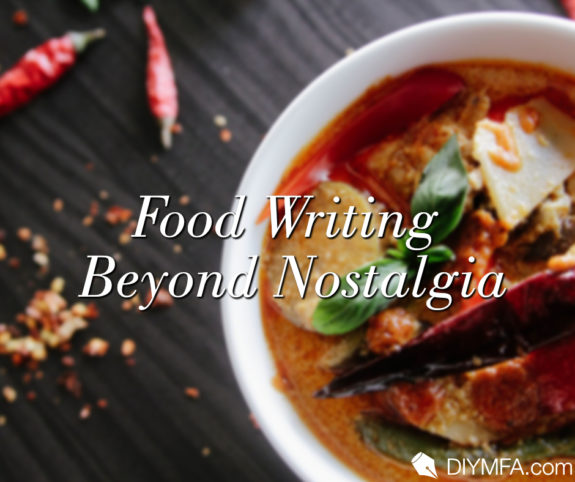If you’re supposed to write what you know, then it makes sense you’d want to linger in the good moments. Food nostalgia is especially intoxicating — the way the salty air bounced off of your cappuccino on a rooftop in Positano or how your main character sat on her porch every evening eating cheesecake and coffee with her husband. Ernest Hemingway romanticized his café visits in Paris so much that they’ve become a feature in city walking tours.
Vivid details enhance your readers’ experience; after all, that’s the sign of a good writer. But at what point do the details not mean as much? When does lingering in the past devolve into pure nostalgia and stop your story from moving forward? And how can you fix it?
There are a few ways, and it starts with insider knowledge. Here are some tips to avoid nostalgia when writing about food:
Show Readers Behind-the-Culinary-Curtain
Food is captivating on one hand because truly good food seems elusive and something people believe only a handful of lucky souls truly get to experience. On the other hand, readers can buy an endless number of books, grocery store items, and kitchen gadgets to fit the smallest spaces. But the one thing readers want more than how to cook the perfect soufflé is access.
You may not craft memoirs like Ruth Reichl, writing about your life as a restaurant critic and the last editor of Gourmet magazine, but you have rich stories, ripe for the writing too.
What started as a blog chronicling a year of cooking through Julia Child’s Mastering The Art of French Cooking, Julie Powell’s Julie and Julia became a bestselling memoir full of calves’ brains, overwhelm, and one woman’s journey to who she really was. Do most foodies own cookbooks by Julia Child’s? Probably. Have most of them cooked through the entire book? Doubtful. Is it more intriguing to see how someone else does it? Absolutely.
Stephanie Danler’s fiction debut, Sweetbitter, is based on her own experiences working as a server in Manhattan. Your readers may not want to work in a trendy New York City restaurant as a 22-year-old trying to find their way in the world, but it’s certainly more fun to watch the drama unfold from a distance.
Most writers take readers behind-the-scenes because they want them to know what it’s “really like.” There’s a generosity that leaks through the pages and makes it impossible to be stuck in one place.
Create an Invitation for Adventure
Be honest: Who hasn’t imagined their own Eat, Pray, Love trip around the world? Walking off bowls of pasta as you wander the streets of Rome? Yes, please! Part of what makes a book like Elizabeth Gilbert’s so enticing is most people think: I could never do that. I’d love to, but I could never.
No matter where you go, food is the common language. We understand how it works and its purpose, even if we’re not familiar with every single tradition. So, an invitation to step outside of your comfort zone automatically removes any sense of nostalgia because you’ve never been there before. The landscape is fresh, and the cutting board is clean.
Bill Buford’s Heat is for every home cook who has imagined working the line and ended up under Mario Battali halfway around the world in Tuscany. This is why travel shows continue to fascinate audiences. The stakes are already raised as you have no idea what to expect, and you have to be open to whatever may come.
You don’t have to travel around the world to create adventure. It could be a memoir exploring food culture in your own backyard or your protagonist could be on a cross-country journey for her grandmother’s vintage cake recipe. But whatever it is, it should give your writing freedom to explore new possibilities you wouldn’t have had if you or your main character would have stayed home.
Focus on What Food Experiences Reveal About Your Characters
Years ago, 6 editorial interns at Rolling Stone competed for a staff position on a national television show. One of the first pieces of feedback their editor gave them was that everyone wrote about what people were wearing at a show and the “feeling in the air,” but no one talked about the music.
The mistake was assuming a common love of music would make people invested in the story. Was it political? Inspired by another local band? Representative of a shift in the genre?
The basic food experience isn’t enough to craft a story. (It hurts because it’s true.)
When you focus on how the morning light hit your mother’s face as she made French-pressed coffee or the feeling of home your character finds in a bowl of soup, you veer into nostalgia, leaving your reader on the other side saying: Why do I care?
Those details reveal nothing about the people in your story and how it connects to the overall narrative. It’s not that you can’t indulge in some nostalgia occasionally, but there should be a more pressing reason your readers are showing up.
Food52’s Amanda Hesser took a one year chronicle of her romance with her now husband and the recipes that made up the 12 months in Cooking for Mr. Latte. The time in the kitchen revealed what their changing relationship meant for Amanda’s own life, from how they entertained to what it was like meeting his mother for the first time.
Amy Tan’s The Joy Luck Club weaves an intricate fictional account of the lives of four Chinese-born women in San Francisco and the gaps between them and their first-generation American daughters all centered around a weekly meal. It’s the cultural experiences of these women that shows what this particular food ritual represents to these women and why it matters.
So as you’re crafting your own food narrative, with every adventure, behind-the-scenes look and mealtime, ask yourself: What is the change taking place and how does that move the story forward?
By focusing on what your characters or audience truly want in life, you won’t be able to stay nostalgic for long. Instead of static scenes full of reminiscing, true desire creates movement and an opportunity to craft more than the good ‘ole days for you and your reader.
[Editor’s Note: This is Amanda Polick’s first column at DIY MFA. She will be contributing a regular food writing column. Please join us in giving her a warm welcome!]

Amanda Polick is a book coach for food and entertainment professionals based in Nashville, Tennessee. When she’s not eating her way through her newest stack of cookbooks, this former actor and improviser can be found looking for her next favorite performer. Her work has been featured in Cooking Light, Food & Wine, and Time and is now a regular columnist for DIYMFA. To reach out or learn more, visit her website for free inspiration and book writing guides.







